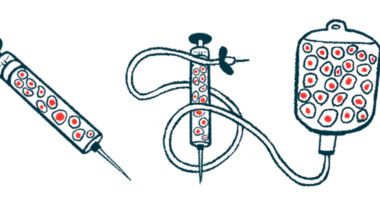Multiple sclerosis and pregnancy: Everything you need to know
Last updated Oct. 18, 2024, by Lindsey Shapiro, PhD

Multiple sclerosis (MS) is a neurological disease that most commonly occurs during childbearing years when many women may be considering starting or growing their family.
For most women, MS is not associated with an increased risk of fertility issues or pregnancy complications. You can expect to have a normal pregnancy and delivery, and pregnancy is not believed to have a negative long-term impact on the course of MS.
Still, when planning a pregnancy you should take into account certain considerations, as not all disease-modifying therapies (DMTs) or medications for managing MS symptoms are safe during pregnancy or breastfeeding.
While many women have fewer MS relapses during the later stages of pregnancy, even after stopping treatment, some MS symptoms may worsen during pregnancy and require adjusting treatment.
Because every person is different, you should work closely with your healthcare team throughout family planning, pregnancy, birth, and the postpartum period to make sure your MS is well controlled and you’re doing what you can to support a healthy pregnancy.
Pregnancy planning
There are many things to consider when planning to start or expand a family — whether or not you have MS.
These may include financial planning, potential career impacts, and optimizing overall health before pregnancy. It’s also generally recommended you maintain a healthy lifestyle by eating a balanced diet, engaging in regular exercise, and avoiding alcohol, drugs, smoking, and excessive stress.
However, women with MS should also take into account a few other factors, including potentially changing treatment plans, managing symptoms during and after pregnancy, and deciding whether to breastfeed. Some fertility and inheritance factors should be considered as well.
Adjusting the MS care plan
Women with MS should talk to their healthcare team if they plan to start a family now or in the future. If you are newly diagnosed, it’s not recommended to delay MS treatment because you are planning on being pregnant — early treatment initiation is the best approach to prevent long-term disability — but it could affect which treatments are chosen.
If you are already being treated for MS, adjustments to your care plan may be needed, especially if you are using certain DMTs before pregnancy that may not be safe for the baby. Your doctors will help determine what changes need to be made and when they should happen.
Women with MS should discuss how medication changes before pregnancy and pregnancy itself are likely to affect their disease course, and how to best prepare for these changes. Doctors also may want to make sure your MS is well controlled before trying to get pregnant.
Fertility considerations
There is no evidence that MS affects fertility and problems with conceiving are as common in people with MS as in the general population. Still, the disease and some medications can cause an irregular menstrual cycle, which may require more careful planning.
Some people with MS experience sexual dysfunction, including a reduction in libido, which can affect getting pregnant. While it can be a sensitive topic, you should always let your doctors know if you’re having sexual problems, as there may be medications or other solutions that can help.
If there are fertility problems, treatments such as in vitro fertilization (IVF) are a viable option for women with MS. While some studies have suggested IVF may increase MS disease activity, more recent studies did not find an increased relapse risk with fertility treatment.
The pros and cons of IVF or other fertility approaches should be discussed with a doctor for each woman’s particular case.
Inheritance
MS is not inherited, but certain genetic factors can increase the risk of developing the condition. If a person has a family history of MS, their risk of having the disease is slightly higher than that of the general population. It’s estimated children born to women with MS have about a 2% chance of developing MS at some point in their lives.
MS cannot be passed to a child through breastfeeding.
MS symptoms during pregnancy
Many women with MS won’t notice any changes in their MS symptoms during pregnancy, and most are able to manage MS and pregnancy with relatively few problems. However, certain MS symptoms are similar to those experienced during pregnancy and may get worse during this period. These include:
- fatigue, which is a common symptom during early pregnancy
- sleep issues, which may make fatigue even worse
- bladder and bowel issues, which may worsen due to pressure on the bladder from the uterus
- urinary tract infections, especially if a person is wheelchair-bound
- mobility issues, which can get worse in the later stages of pregnancy due to the extra weight.
Certain symptoms may worsen if you have to stop specific medications while pregnant. In those cases, your healthcare provider can suggest other strategies to manage symptoms, so it is always important to let a doctor know about any new or worsening symptoms.
MS relapses
For those with relapsing forms of MS, overall relapse rates during the entire pregnancy and early postpartum months are similar to rates seen before and after pregnancy. Still, research indicates relapses are generally less frequent in the last trimester compared with before pregnancy, and are slightly more common than before conception in the months after delivery.
While scientists don’t know exactly why this happens, it’s believed to be related to pregnancy hormones, including estrogen and progesterone, which are at their highest levels in the last trimester. Among their many functions, these hormones suppress the immune system to ensure the mother’s body does not reject the developing fetus.
After delivery, and also in the case of pregnancy loss and abortion, the levels of these hormones decrease abruptly, so women with MS tend to experience an increased rate of relapses in the six months after compared with pre-pregnancy rates. That rate, however, tends to return to pre-pregnancy levels about 10-12 months after delivery.
In the case of an early pregnancy loss, a woman should discuss her MS care plan with her doctor.
Long-term outlook
Overall, there are not enough studies on how pregnancy affects the course of primary progressive MS, but existing evidence in relapsing forms of MS suggests pregnancy does not have a long-term negative impact. In fact, some research suggests pregnancy and childbirth may instead be associated with less disability accumulation in the long-term.
Potential risks and complications
Studies looking at MS and pregnancy risks have generally found women with MS are not more likely than healthy women to experience pregnancy complications such as a miscarriage, stillbirth, or preterm labor. Moreover, an MS pregnancy is not expected to increase the risk of birth defects compared with pregnancies in healthy women.
Despite the lower rate of relapses observed in the final months of pregnancy, there is always the possibility that a relapse will occur. Having a relapse during pregnancy does not adversely affect a developing fetus, but it’s important that you reach out promptly to your healthcare team if you experience any signs of MS relapse, no matter how mild.
You should not try to treat MS relapse symptoms without first talking to your doctors. They are best equipped to develop a treatment strategy that prioritizes your safety and that of your developing fetus.
MS treatment during pregnancy
Decisions regarding what medication to use during pregnancy should be made through a collaborative discussion between you and your healthcare team, including your neurologist, primary care physician, and obstetrician.
The kind of MS treatment during pregnancy will depend on factors such as the medication’s safety profile, symptoms, and risk of disease progression, as well as your own preferences.
Ideally, you should discuss this topic with your healthcare team before trying to conceive. But if you become pregnant before care changes are considered and set in place, it’s important to let your doctors know right away and create a plan for stopping, changing, or adding any treatments.
Disease-modifying therapies
While no DMT is specifically approved for use during pregnancy in the U.S., growing evidence has led to the development of MS and pregnancy guidelines to help doctors make safer treatment decisions.
Many DMTs have known risks and will need to be discontinued either in the months before conception or when pregnancy occurs. But there are also a few that are generally considered safe, including interferon-beta medications, and others such as anti-CD20 inhibitors that may be used if the potential benefits to the mother outweigh the potential risks to the developing fetus.
For DMTs that may be used if the benefits outweigh the risks, most have limited data on their use during pregnancy. Some may be safe up until the time of conception, or for a few months into pregnancy with an altered dosing regimen.
Regardless of the drug being used before pregnancy, it’s important to always discuss with a healthcare provider before stopping or changing any medications, as these changes may make MS worse.
If a woman with MS is exposed to a DMT during pregnancy, there are a number of registries that monitor their and their babies’ outcomes to gather more data about potential risks of using specific medications. You should talk to your doctor about enrolling into active registries.
Other treatments
Some medications used to manage specific MS symptoms may not be safe to continue during pregnancy. These include certain drugs for fatigue, mobility issues, and muscle spasticity. But there are other medications that may be used with caution during pregnancy if there is a clear clinical need.
This is why it’s important you let your healthcare team know about all the medications you’re taking as soon as you are considering getting pregnant or are pregnant. Your doctor will be able to advise you about which ones are safe for you and whether there are alternative medications or other strategies for managing MS symptoms.
Women with MS also are advised to take vitamin D supplements during pregnancy, as vitamin D deficiency during early pregnancy has been associated with an increased risk of MS in an offspring. A doctor will recommend an appropriate dose based on your specific situation.
If a severe MS relapse occurs, being given standard corticosteroids, including prednisone and methylprednisolone, directly into the bloodstream is considered safe in the second and third trimester. Some doctors may recommend avoiding these treatments during the first trimester as limited research has linked exposure to steroids to possible fetal malformations.
Giving birth
Like all women, those with MS should carefully plan their birthing experience ahead of time. This includes where you want to give birth, who should be present, and how to handle potential MS and pregnancy complications. It’s important to create this plan in collaboration with your healthcare team.
Labor and delivery are not usually affected by MS and there isn’t an increased risk of serious birthing complications. Still, a vaginal delivery may be complicated by symptoms such as severe muscle weakness, spasticity, or fatigue. If you are experiencing these symptoms you may need a more tailored birthing plan. Your doctor may recommend specific birthing positions or other adjustments to make your birthing experience easier.
In general, most forms of pain relief, including epidurals, are considered safe for women with MS. If a cesarean section or other intervention is needed, all forms of anesthesia are typically safe.
Self-care after birth
After the birth of their newborn, women with MS have to balance caring for their infant with managing their own specific health needs. Navigating the postpartum period with MS involves typical concerns, such as postpartum self-care and breastfeeding, as well as MS-specific considerations such as whether to start DMTs after pregnancy and other ways to manage symptoms.
For example, women with MS may be at an increased risk for postpartum depression, especially if they have stopped taking certain antidepressants before pregnancy. Having a support system in place ahead of time can help new mothers with MS be prepared for any emotional changes, but you should also discuss with your doctors if it is safe to address depression with specific treatments.
Breastfeeding is safe for women with MS and has known health benefits for the infant. Some studies have shown that exclusive breastfeeding has been linked to a reduced risk of MS relapse in the postpartum period.
Since most medications that are not safe during pregnancy should also not be used while breastfeeding, deciding to nurse may mean staying off some treatments for a few months after delivery, which may affect MS symptoms.
For these reasons, the decision about breastfeeding, bottle feeding, or a combination should be based on what works best for you and your baby. Women and their doctors should discuss MS treatment and care after delivery in advance to make sure their disease remains well controlled.
Multiple Sclerosis News Today is strictly a news and information website about the disease. It does not provide medical advice, diagnosis or treatment. This content is not intended to be a substitute for professional medical advice, diagnosis, or treatment. Always seek the advice of your physician or another qualified health provider with any questions you may have regarding a medical condition. Never disregard professional medical advice or delay in seeking it because of something you have read on this website.
Related articles







